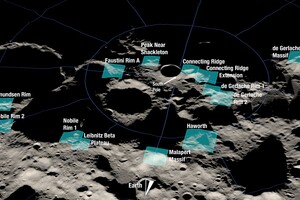Launching astronauts to Earth's satellite will be part of the Artemis mission.

NASA is preparing to launch the mission ” Artemis”, as part of which it is planned to land people on the moon. The agency has selected 13 regions to consider as potential landing sites for this mission. The list of regions was published on the NASA website.
Read also: South Korea launched an orbital probe to explore the moon
All selected regions are at the south pole of the Moon. These included: the elevation near the Shackleton crater, the Faustini crater rim, the two De Gerlach crater rims, the ridge connecting the Shackleton and de Herlach craters and the area adjacent to it, the Haworth crater, the Nobile crater rim, the Amundsen crater rim, the plateau Leib, de Gerlach Kocher massif and Malapert massif.
According to the agency, each selected area is within 6 degrees of latitude from the moon's south pole. All of them also have different geological features. Potential landing regions were selected by NASA using data collected by the Lunar Reconnaissance Orbiter probe.
All selected regions are considered to be of great scientific interest due to their proximity to the Moon's south pole. This area contains many permanently shadowed regions, rich in resources, as well as unexplored terrain.
Some of these regions are located in the oldest parts of the Moon, which may help to learn more about the history of Earth's satellite.
Also, the selection of sites took into account the criteria necessary for a safe landing: the topography of the area, the possibility of communication with the Earth, lighting and the capabilities of the Space Launch System (SLS) carrier rocket, the Orion spacecraft and the modification of the Starship rocket for landing astronauts on the surface of the Moon .
pictures taken on May 25 show a double crater formed by the collision.




